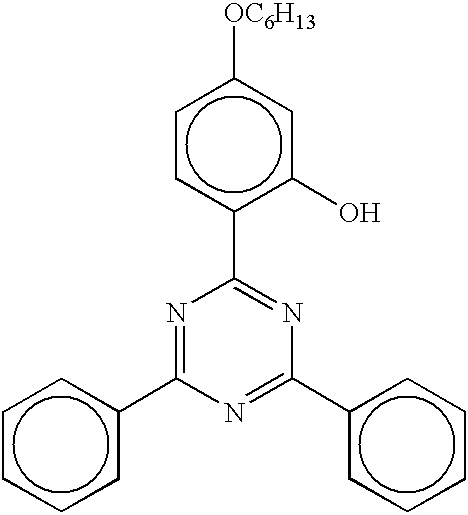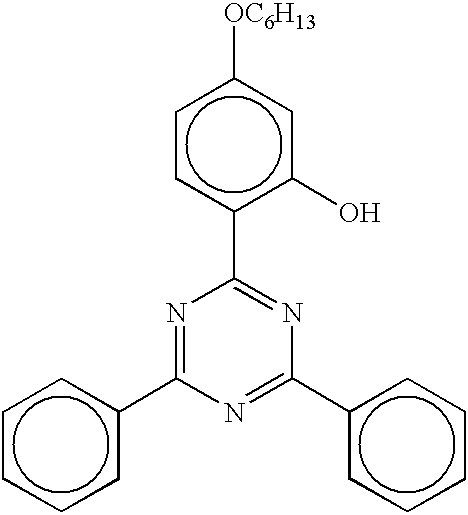White, UV-stabilized film made from a crystallizable thermoplastic
a thermoplastic and crystallization technology, applied in the field of white, can solve the problems of inability to adapt to outdoor applications, films and items produced from them, and inability to meet the requirements of outdoor applications, and achieve the effects of low yellowness index, good mechanical and optical properties, and good orientability
- Summary
- Abstract
- Description
- Claims
- Application Information
AI Technical Summary
Benefits of technology
Problems solved by technology
Method used
Image
Examples
example 1
[0104]A white film is produced which has a thickness of 50 μm and comprises, as principal constituent, polyethylene terephthalate, 7.0% by weight of titanium dioxide and 1.0% by weight of the UV stabilizer 2-(4,6-diphenyl-1,3,5-triazin-2-yl)-5-(hexyloxy)phenol (®Tinuvin 1577 from Ciba-Geigy).
[0105]The titanium dioxide is of rutile type and its average particle diameter is 0.20 μm, and it has a coating of Al2O3.
[0106]Tinuvin 1577 has a melting point of 149° C. and is thermally stable to about 330° C.
[0107]To achieve uniform distribution, 7.0% by weight of titanium dioxide and 1.0% by weight of the UV stabilizer are incorporated directly into the polyethylene terephthalate by the raw material producer.
[0108]The polyethylene terephthalate used to produce the white film has a standard viscosity SV (DCA) of 810, corresponding to an intrinsic viscosity IV (DCA) of 0.658 dl / g. The moisture content is <0.2%.
[0109]The white PET film produced has the following property profile:
[0110]
Thickness...
example 2
[0113]A white film is produced in a manner similar to that of Example 1. The UV stabilizer 2-(4,6-diphenyl-1,3,5-triazin-2-yl)-5-(hexyloxy)phenol (®Tinuvin 1577) is fed in the form of a masterbatch. The masterbatch is composed of 5% by weight of Tinuvin 1577 as active component and 95% by weight of the polyethylene terephthalate of Example 1.
[0114]Prior to extrusion, 90% by weight of the titanium-dioxide-containing polyethylene terephthalate of Example 1 are dried with 10% by weight of the masterbatch at 170° C. Extrusion and film production are carried out in a manner similar to that of Example 1.
[0115]The white PET film produced has the following property profile:
[0116]
Thickness50μmSurface gloss, side 174(Measurement angle 20°) side 271Luminous transmittance27%Surface defects (fish-eyes,noneorange peel, bubbles, etc.)Longitudinal mod. of elasticity4200N / mm2Transverse mod. of elasticity5650N / mm2Longitudinal tear resistance160N / mm2Transverse tear resistance250N / mm2Longitudinal elong...
example 3
[0119]A white film of 350 μm thickness is produced in a manner similar to that of Example 2. The PET film produced has the following property profile:
[0120]
Thickness350μmSurface gloss, side 170(Measurement angle 20°) side 260Luminous transmittance10%Surface defects per m2none(fish-eyes, orange peel, bubbles,etc.)Yellowness Index50Longitudinal mod. of elasticity3600N / mm2Transverse mod. of elasticity4200N / mm2Longitudinal tear resistance180N / mm2Transverse tear resistance200N / mm2Longitudinal elongation at break220%Transverse elongation at break190%
[0121]After 1000 hours of weathering per side with an Atlas Ci 65 Weather-Ometer the PET film has the following properties:
[0122]
Thickness350μmSurface gloss, side 168(Measurement angle 20°) side 265Luminous transmittance9%Surface defects (cracks,noneembrittlement)Yellowness Index (YID)52Longitudinal mod. of elasticity3500N / mm2Transverse mod. of elasticity4050N / mm2Longitudinal tear resistance165N / mm2Transverse tear resistance185N / mm2Longitudina...
PUM
| Property | Measurement | Unit |
|---|---|---|
| thickness | aaaaa | aaaaa |
| particle size | aaaaa | aaaaa |
| luminous transmittance | aaaaa | aaaaa |
Abstract
Description
Claims
Application Information
 Login to View More
Login to View More - R&D
- Intellectual Property
- Life Sciences
- Materials
- Tech Scout
- Unparalleled Data Quality
- Higher Quality Content
- 60% Fewer Hallucinations
Browse by: Latest US Patents, China's latest patents, Technical Efficacy Thesaurus, Application Domain, Technology Topic, Popular Technical Reports.
© 2025 PatSnap. All rights reserved.Legal|Privacy policy|Modern Slavery Act Transparency Statement|Sitemap|About US| Contact US: help@patsnap.com



